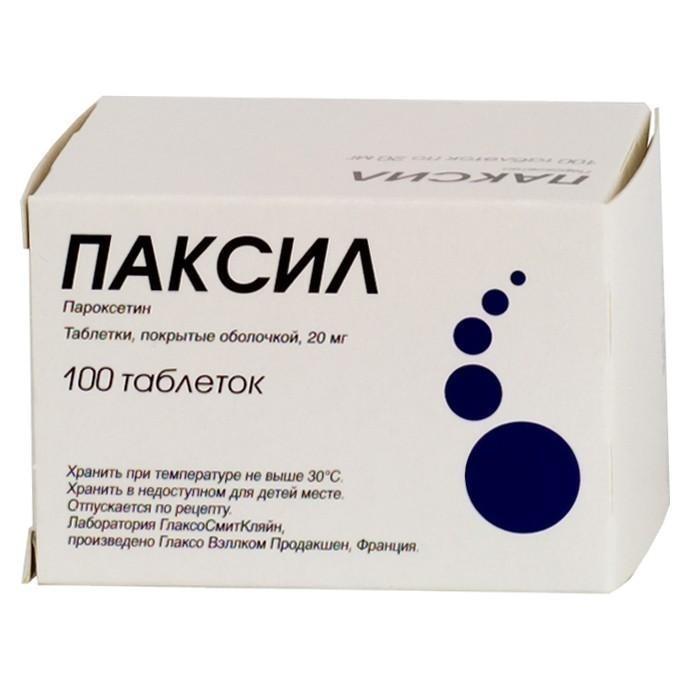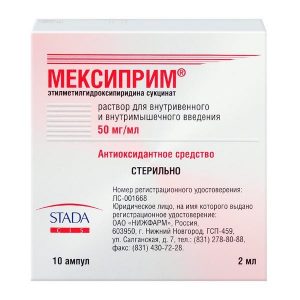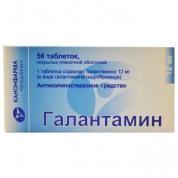Description
Release form
Coated tablets
Packing
100 pcs.
Pharmacological action
Paxil – antidepressant. Selectively blocks the reuptake of serotonin, increases its concentration in the synaptic cleft and causes an antidepressant effect.
It has low affinity for muscarinic cholinergic receptors, for alpha-1, alpha-2, beta-adrenergic receptors, as well as 5-HT_1-like, 5-HT_2-like and histamine (H_1) receptors.
Does not violate psychomotor functions and does not potentiate the inhibitory effect of ethanol on them.
Antidepressant effect appears after 7-14 days of systematic administration. During treatment, there is a decrease in anxiety, depression, and normalization of sleep.
Indications
– Depression of all types, including reactive depression, severe endogenous depression and anxiety-related depression (results of studies in which patients received the drug for 1 year show that it is effective in preventing relapse of depression).
– Treatment (including maintenance and prophylactic therapy) of obsessive-compulsive disorder (OCD) in adults, as well as in children and adolescents aged 7-17 years (the preservation of the effectiveness of the drug in the treatment of OCD for at least 1 year and in the prevention of relapse of OCD has been proven).
– Treatment (including maintenance and prophylactic therapy) of a panic disorder with agoraphobia and without it (the effectiveness of the drug persists for 1 year, preventing relapse of panic disorder).
– Treatment (including maintenance and prophylactic therapy) of social phobia in adults, as well as in children and adolescents aged 8-17 years (the effectiveness of the drug persists with prolonged treatment of this disorder).
– Treatment (including maintenance and prophylactic therapy) of generalized anxiety disorder (the effectiveness of the drug persists with prolonged treatment of this disorder, preventing relapse of this disorder).
– Treatment for post-traumatic stress disorder.
Contraindications
– Concomitant use of MAO inhibitors and a period of 14 days after their withdrawal (MAO inhibitors should not be prescribed within 14 days after the end of treatment with paroxetine).
– Concomitant use of thioridazine.
– Hypersensitivity to paroxetine and other components of the drug.
Use during pregnancy and lactation
In experimental studies, no teratogenic or embryotoxic effects of paroxetine were detected.
Data on a small number of women who took paroxetine during pregnancy indicate no increased risk of congenital malformations in newborns. There are reports of premature birth in women who received paroxetine during pregnancy, but a causal relationship with the drug has not been established.
Paxil should not be used during pregnancy, unless the potential benefit of the treatment outweighs the potential risk associated with taking the drug.
It is necessary to monitor the health status of newborns whose mothers took paroxetine in late pregnancy, as there are reports of complications in children (however, a causal relationship with the drug has not been established). Respiratory distress syndrome, cyanosis, apnea, seizures, temperature instability, feeding difficulties, vomiting, hypoglycemia, arterial hyper- or hypotension, hyperreflexia, tremor, irritability, lethargy, constant crying, drowsiness. In some reports, symptoms have been described as neonatal manifestations of withdrawal.
In most cases, the described complications occurred immediately after childbirth or shortly after (within 24 hours). Paroxetine in small amounts is excreted in breast milk. Therefore, the drug should not be used during lactation, unless the potential benefit of the treatment exceeds the possible risk associated with taking the drug.
Special instructions
Should be taken with caution in case of renal and hepatic insufficiency, angle-closure glaucoma, prostatic hyperplasia, mania, cardiac pathology, epilepsy, convulsive states, in combination with electropulse therapy, in patients receiving drugs that increase the risk of bleeding, with factors risk of increased bleeding.
During treatment, refrain from drinking alcohol.
Use with caution while working for drivers of vehicles and people whose profession is associated with increased concentration of attention.
With abrupt cancellation – dizziness, sensory disturbances, sleep disturbance, agitation, anxiety, nausea, sweating.
Caution should be exercised when administered in combination with lithium preparations.
For the duration of treatment should refrain from the use of ethanol.
Composition
1 tablet contains:
paroxetine hydrochloride hemihydrate 22.8 mg, which corresponds to paroxetine 20 mg.
Excipients:
calcium dihydrogen phosphate dihydrate,
sodium carboxy starch type A,
magnesium stearate.
Shell Composition:
hypromellose,
titanium dioxide,
macrogol 400,
polysorbate 80.
Dosage and administration
Inside, in the morning – 20 mg.
If the effect is insufficient, a dose increase of 10 mg / day is possible with an interval of at least 1 week (maximum dose is 50 mg / day).
In elderly, malnourished patients, and also in case of impaired renal and hepatic function, the initial dose is 10 mg / day, the maximum is 40 mg / day.
Side effects
Drowsiness or insomnia, tremor, nervousness, increased excitability of the central nervous system, impaired concentration, emotional lability, amnesia, pain in the eyes, eye pain, pain, increase or decrease in blood pressure, fainting, tachycardia or bradycardia, impaired cardiac conduction and peripheral circulation, cough, rhinitis, dipnoea, tachypnea, nausea, decreased appetite, dyspepsia, increased liver activity transaminase, stomatitis, arthralgia, arthritis, dysuria, polyuria, incontinence, urinary retention, amenorrhea, dysmenorrhea, miscarriage, mastitis, impaired ejaculation, decreased libido and potency, peripheral edema, decreased or increased body weight, anemia, leukopenia, allergic reactions (itching, urticaria, chills). Rarely – impaired thinking, akinesia, ataxia, convulsions, hallucinations, hyperkinesia, manic or paranoid reactions, delirium, euphoria, major epileptic seizures, aggressiveness, nystagmus, stupor, autism, decreased visual acuity, cataracts, conjunctivitis, glaucoma, stenocardia myocardial infarction, cerebrovascular accident, cardiac arrhythmias, eosinophilia, leukocytosis, lymphocytosis, monocytosis, hematuria, nephrourolithiasis, impaired renal function, dermatitis, erythema nodosum, depigmentation.
Drug interaction
Inductors of microsomal oxidation (phenobarbital, phenytoin) reduce blood concentration and activity, inhibitors (cimetidine) increase. Increases the level of procyclidine in plasma.
Incompatible with MAO inhibitors. Co-administration with indirect anticoagulants can cause increased bleeding with unchanged prothrombin time. Enhances the effect of alcohol.
overdose Available information on paroxetine overdose indicates a wide range of safety.
Symptoms: increased side effects described above, vomiting, pupil dilation, fever, changes in blood pressure, involuntary muscle contractions, agitation, anxiety, tachycardia.
Patients usually do not develop serious complications, even with a single intake of up to 2 g of paroxetine. In some cases, coma and changes in the EEG develop, very rarely a lethal outcome with the combined use of paroxetine with psychotropic drugs or alcohol.
Treatment: standard measures used in the overdose of antidepressants (gastric lavage by artificial vomiting, administration of 20-30 mg of activated charcoal every 4-6 hours during the first day after overdose). The specific antidote is unknown. Supportive therapy and control of vital functions of an organism are shown.
Storage conditions
Store in a dry place at a temperature not exceeding 30 °.
Shelf life
3 years.
Deystvuyushtee substance
Paroxetine
Terms and conditions
prescription
dosage form
tablets
Possible product names
Paxil tablets 20 mg, 100 pcs.
PAXIL 0.02 N100 TABLE P / O
Paxil 20 mg No. 100
Paxil 20 mg Tab. p / o X100 (R)
Paxil 20mg Tab. n / a X100 (R) /! until 09.11g /




